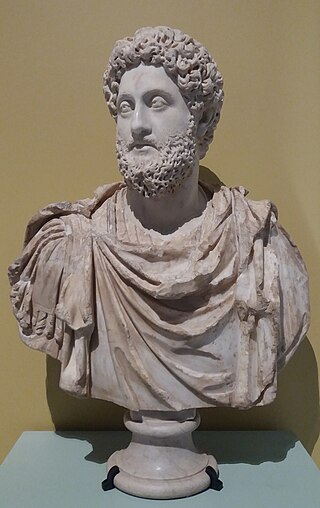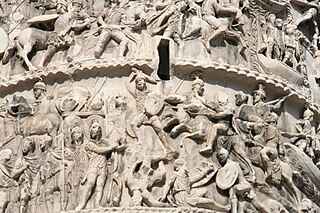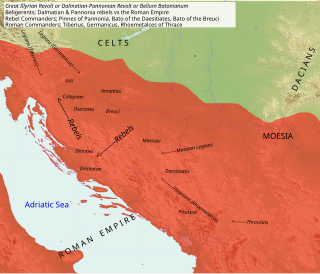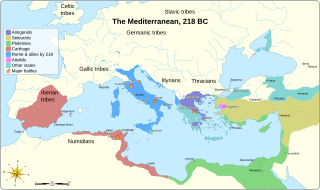Further reading
- Kovács, Peter (2008). Marcus Aurelius' Rain Miracle and the Marcomannic Wars. Brill. ISBN 978-90-47-44326-1.
Arnouphis or Harnouphis was an Egyptian who, according to Dio Cassius, saved the Roman legion XII Fulminata during a campaign against the Quadi in about AD 172 by calling up a rainstorm. [1] Dio Cassius calls Arnouphis a magos , originally a term for Zoroastrian priests. David Frankfurter says that Arnouphis was an Egyptian priest, but he was called a magos because Romans regarded priests from many Near Eastern cultures as fitting a single stereotype of exotic magicians. [2]

Gaius Julius Caesar Augustus Germanicus, better known by his nickname Caligula, was the third Roman emperor, ruling from 37 until his assassination in 41. He was the son of the Roman general Germanicus and Augustus' granddaughter Agrippina the Elder. Caligula was born into the first ruling family of the Roman Empire, conventionally known as the Julio-Claudian dynasty.

Marcus Antonius, commonly known in English as Mark Antony, was a Roman politician and general who played a critical role in the transformation of the Roman Republic from a constitutional republic into the autocratic Roman Empire.

Vespasian was a Roman emperor who reigned from AD 69 to 79. The fourth and last emperor who reigned in the Year of the Four Emperors, he founded the Flavian dynasty that ruled the Empire for 27 years. His fiscal reforms and consolidation of the empire generated political stability and a vast Roman building program.
6 was a common year starting on Friday of the Julian calendar. In the Roman Empire, it was known as the Year of the Consulship of Lepidus and Lucius Arruntius. The denomination "AD 6" for this year has been used since the early medieval period, when the Anno Domini calendar era became the prevalent method in Europe for naming years.

Commodus was a Roman emperor who ruled from 177 to 192. He served jointly with his father Marcus Aurelius from 177 until the latter's death in 180, and thereafter he reigned alone until his assassination. His reign is commonly thought of as marking the end of a golden period of peace in the history of the Roman Empire, known as the Pax Romana.

Alexander Helios was a Ptolemaic prince and son of Pharaoh Cleopatra VII of the Ptolemaic dynasty and Roman triumvir Mark Antony. Alexander's fraternal twin sister was Cleopatra Selene II. Cleopatra named her son after Alexander the Great. His second name in Ancient Greek means "Sun"; this was the counterpart of his twin sister's second name Selene (Σελήνη), meaning "Moon".
Ptolemy XVI Philadelphus Antonius was a Ptolemaic prince and was the youngest and fourth child of Greek Ptolemaic Queen Cleopatra VII of Egypt, and her third with Roman Triumvir Mark Antony.

Legio XII Fulminata, also known as Paterna, Victrix, Antiqua, Certa Constans, and Galliena, was a legion of the Imperial Roman army. It was originally levied by Julius Caesar in 58 BC, and the legion accompanied him during the Gallic Wars until 49 BC. The unit was still guarding the Euphrates River crossing near Melitene at the beginning of the 5th century.

Legio II Traiana, was a legion of the Imperial Roman army raised by emperor Trajan, along with XXX Ulpia Victrix, for the campaigns in Dacia. Records of the II Traiana Fortis have been recovered from Egypt dating to the middle of the 5th century. The legion's emblem was the demi-god Hercules.
Gaius Avidius Cassius was a Syrian Roman general and usurper. He was born in Cyrrhus, and was the son of Gaius Avidius Heliodorus, who served as praefectus or governor of Roman Egypt, and Julia Cassia Alexandra, who was related to a number of royal figures, including her descent from both Augustus and Herod the Great. He began his military career under Antoninus Pius, rising to the status of legatus legionis. He served during the Parthian war of Lucius Verus, in which he distinguished himself, for which he was elevated to the Senate, and later made Imperial legate. During the Bucolic War, he was given the extraordinary title of Rector Orientis, giving him Imperium over all of the eastern provinces of the Roman Empire.

Artavasdes II was king of Armenia from 55 BC to 34 BC. A member of the Artaxiad Dynasty, he was the son and successor of Tigranes the Great. His mother was Cleopatra of Pontus, thus making his maternal grandfather the prominent Pontus king Mithridates VI Eupator. Like his father, Artavasdes continued using the title of King of Kings, as seen from his coins.

The Marcomannic Wars were a series of wars lasting from about 166 until 180 AD. These wars pitted the Roman Empire against, principally, the Germanic Marcomanni and Quadi and the Sarmatian Iazyges; there were related conflicts with several other Germanic, Sarmatian and Gothic peoples along both sides of the whole length of the Roman Empire's northeastern European border, the river Danube.

The Bellum Batonianum was a military conflict fought in the Roman province of Illyricum in the 1st century AD, in which an alliance of native peoples of the two regions of Illyricum, Dalmatia and Pannonia, revolted against the Romans. The rebellion began among native peoples who had been recruited as auxiliary troops for the Roman army. They were led by Bato the Daesitiate, a chieftain of the Daesitiatae in the central part of present-day Bosnia and Herzegovina, and were later joined by the Breuci, a tribe in Pannonia led by Bato the Breucian. Many other tribes in Illyria also joined the revolt.
The gens Quinctilia, also written Quintilia, was a patrician family at ancient Rome, dating from the earliest period of Roman history, and continuing well into imperial times. Despite its great antiquity, the gens never attained much historical importance. The only member who obtained the consulship under the Republic was Sextus Quinctilius in 453 BC. The gens produced numerous praetors and other magistrates, but did not obtain the consulship again for over four hundred years.

The Battle of Insubria in 203 BC was the culmination of a major war, carried out by the Carthaginian commander Mago, brother of Hannibal Barca, at the end of the Second Punic war between Rome and Carthage in what is now northwestern Italy. Mago had landed at Genoa, Liguria, two years before, in an effort to keep the Romans busy to the North and thus hamper indirectly their plans to invade Carthage's hinterland in Africa. He was quite successful in reigniting the unrest among various peoples against the Roman dominance. Rome was forced to concentrate large forces against him which finally resulted in a battle fought in the land of the Insubres (Lombardy). Mago suffered defeat and had to retreat. The strategy to divert the enemy's forces failed as the Roman general Publius Cornelius Scipio laid waste to Africa and wiped out the Carthaginian armies that were sent to destroy the invader. To counter Scipio, the Carthaginian government recalled Mago from Italy. However, the remnants of the Carthaginian forces in Cisalpine Gaul continued to harass the Romans for several years after the end of the war.
Isidorus was a native ancient Egyptian priest in the 2nd century during the Roman rule in Egypt. He led the native Egyptian revolt against Roman rule during the reign of emperor Marcus Aurelius. The likely motivation for the revolt was the uptick in taxes imposed by Aurelius to fund the war in the North.
Quintus Dellius was a Roman commander and politician in the second half of the 1st century BC. His family was of equestrian rank in the Roman social system of status.

Donatus of Muenstereifel is a catacomb saint whose relics are found in the Jesuit church in Bad Muenstereifel. He is widely venerated in the Rhine valley region of Germany and the Low Countries, and he is a patron saint of Buda and of protection against lightning. His relics were translated to Muenster Eifel in the 17th century from the Catacombs of Rome, where he had been originally buried.
The battle off Carteia was a minor naval battle during the latter stages of Caesar's Civil War won by the Caesarians led by Caesar's legate Gaius Didius against the Pompeians led by Publius Attius Varus.
The Siege of Apamea was a failed attempt by the Caesarians near the end of Caesar's Civil War to capture the rebel city of Apamea, Syria Secunda. Lucius Statius Murcus and Quintus Marcius Crispus led the attempt to capture the city, while Equite Quintus Caecilius Bassus led the defence of the city.